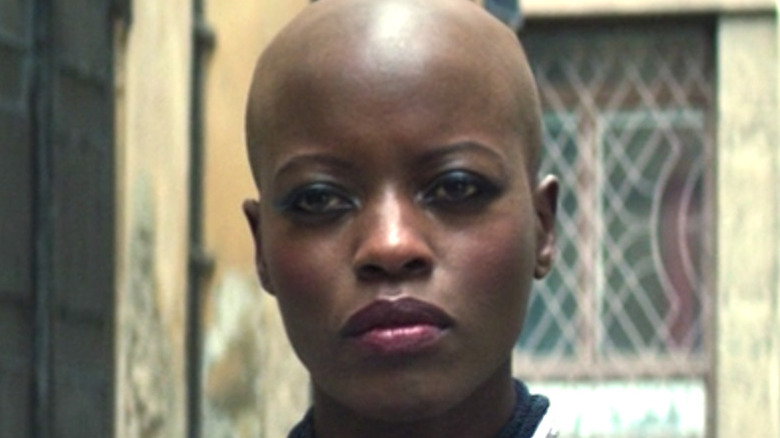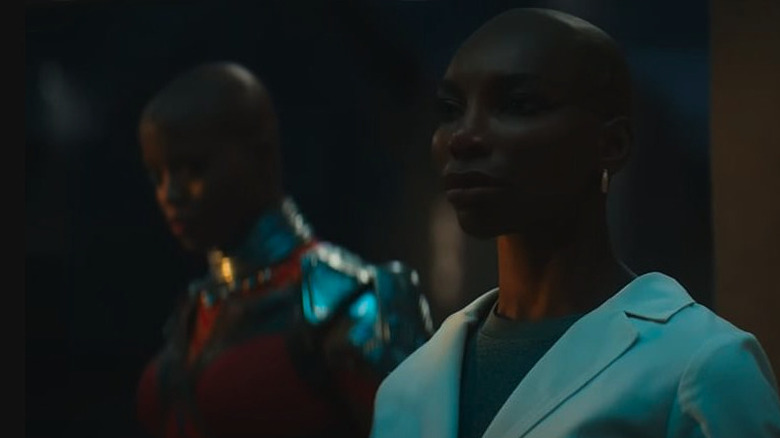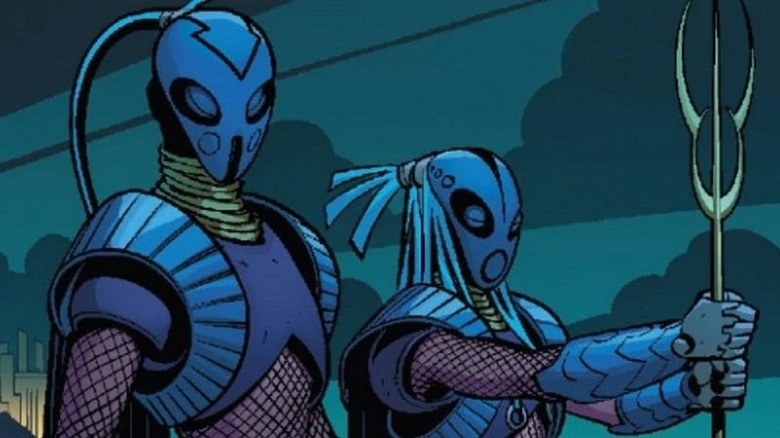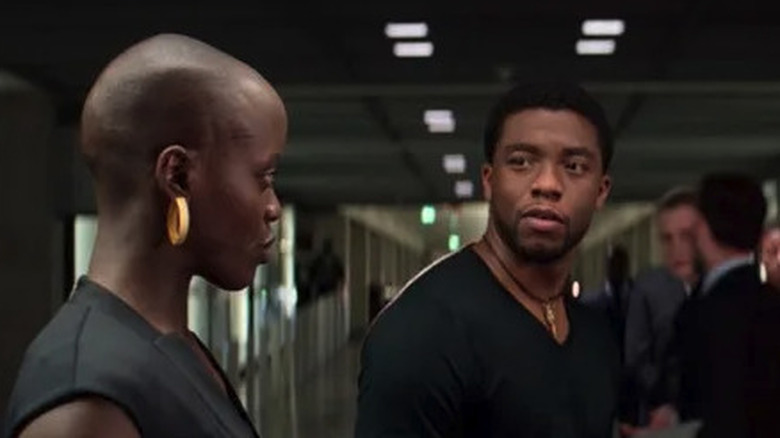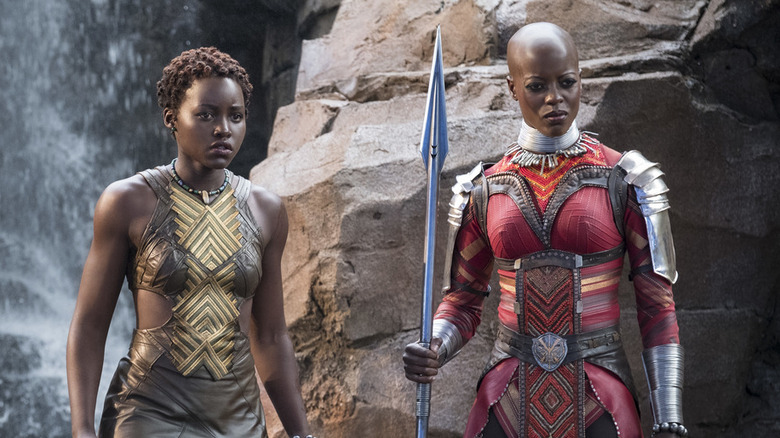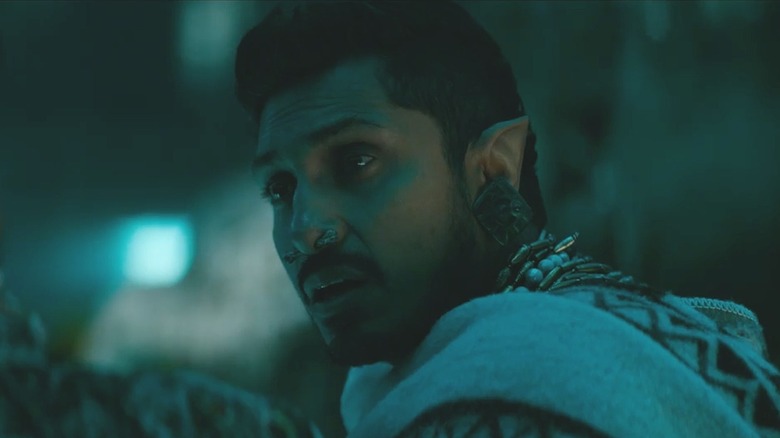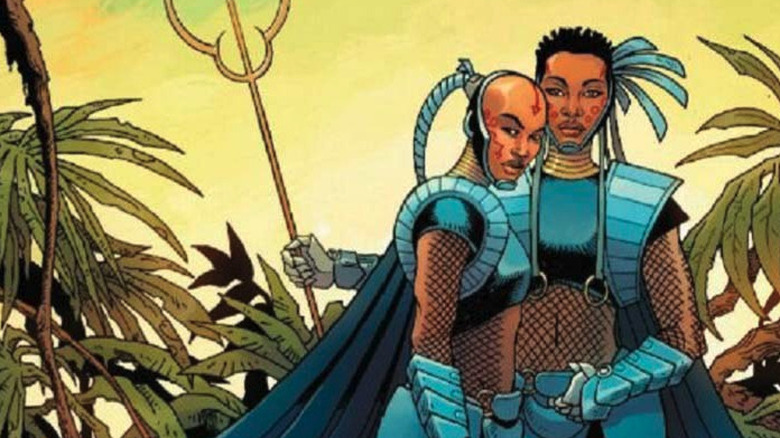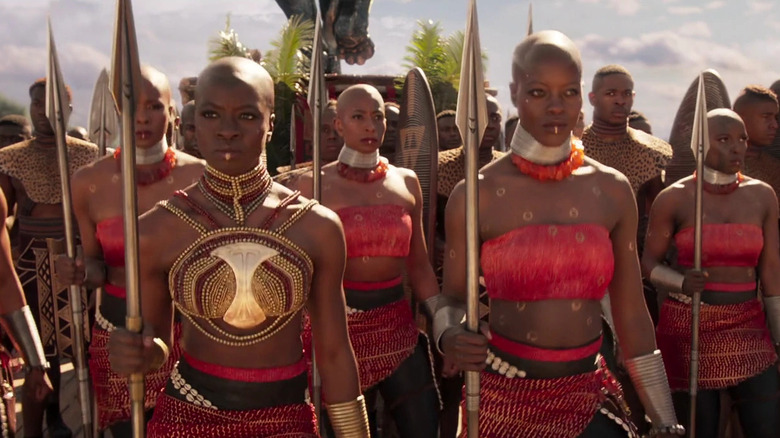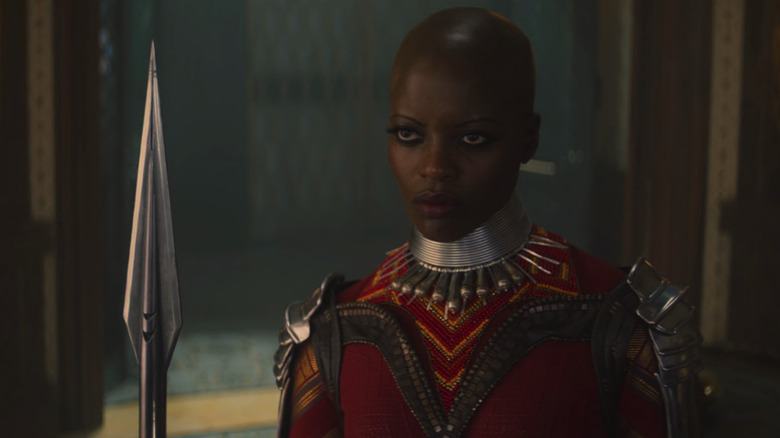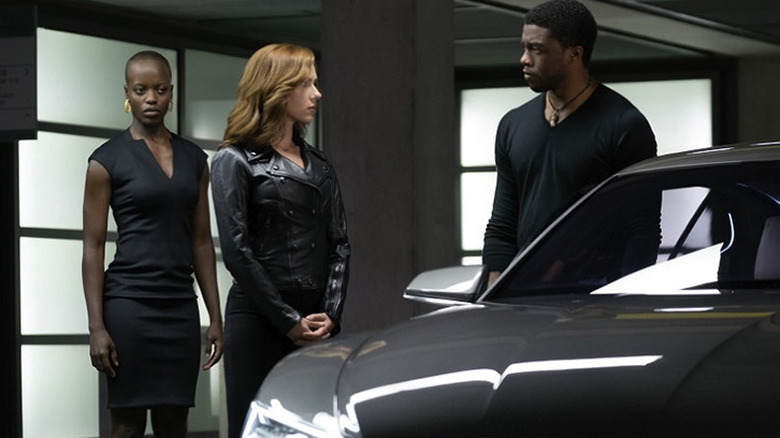Facts Only Huge Fans Know About Black Panther's Ayo
"Black Panther: Wakanda Forever" arrived with big shoes to fill, not only marking the end of Phase 4 in the MCU, but also moving a franchise along without its lead actor and Black Panther himself, Chadwick Boseman. After the tragic passing of Boseman in August 2020, questions of director Ryan Coogler's intentions turned to rumors about T'Challa being recast, Killmonger returning from the dead, Shuri (Letitia Wright) taking up the mantle or other possible storylines.
Coogler appeased fans and critics by crafting a satisfying end to T'Challa while looking towards a bright future for the kingdom of Wakanda. Although "Wakanda Forever" is very much a tribute to Boseman, the filmmaker falls back on the comics — and one of many ways the series is returned to its roots is in the character Aneka (Michaela Coel) and her relationship to Ayo (Florence Kasumba).
Ayo has been a part of Wakanda's MCU story since the beginning, but her character has a deeper, comic history that benefits from closer inspection via the introduction of Aneka. Below, a breakdown of 10 Ayo facts that will deepen your understanding of where she's coming from.
Ayo and Aneka's relationship
Much like in the MCU, Ayo was introduced in the comics as a faithful soldier of the Dora Milaje. However, things went awry as the kingdom of Wakanda faced danger. The first several issues of the 2016-2018 "Black Panther" series detailed how Wakanda had become a broken nation, with the king unsure of how to repair the kingdom. These Black Panther stories revolved around how the throne clashed with its closest allies, the Dora Milaje — and it was here where audiences got to learn more about Ayo.
In the comics, she clashes with the throne when her partner (and love of her life) Aneka has been arrested by Queen Mother Ramonda, who argues that Aneka has gone rogue. Ayo begs the Queen for mercy, with Aneka set to face a harsh punishment. While Ramonda is somewhat sympathetic to Ayo's plight, she does not release Aneka from the punishment, causing Ayo to take matters into her own hands. She moves against the throne to rescue Aneka, resulting in the two becoming exiles from Wakanda and the Dora Milaje for the time being.
In the "Black Panther" films, Ayo is always loyal to the crown, with only a hint of her relationship with Aneka at the end of "Wakanda Forever." If anything, Aneka seems to be the more rebellious of the two.
The history of the Midnight Angels
In "Wakanda Forever," Shuri has developed a new suit for the Dora Milaje, much to the chagrin of General Okoye (Danai Gurira). But by the end of the film, Okoye and Aneka are wearing the suits to defend Wakanda against the people of Namor's underwater kingdom, Talokan. For those watching the film, the suits may have seemed out of place — but for die-hard fans of these characters, they represent a celebrated element of Wakanda's comic book history: The Midnight Angels.
In the "Black Panther" comics, when Ayo decides to free Aneka from her hearing, she borrows (or steals, depending on your perspective) the Midnight Angel gear to break her out. Once free, Anyo gives Aneka the other suit, and the two go on their own mission without the backing of the throne or the Dora Milaje.
Initially, Aneka was arrested because she took action against violent men. Once free, the two embark on their own crusade to stop further violence against unarmed, unprotected women within the kingdom of Wakanda. This version of Ayo is not one who blindly follows the rules and traditions of her king. Instead, she is angry and uses her skills to fight for her own version of justice, feeling that the throne is no longer fit to do so.
Ayo's complex relationship with T'Challa
In the films, Ayo and T'Challa do not interact much. Perhaps their most significant encounter is in "Captain America: Civil War," when Ayo instructs Black Widow to move out of her king's way, much to his amusement. T'Challa understands the weight behind her actions, smirking to ease the tension between the two formidable women.
However, Ayo's relationship with her king is more complex in the comics. Upon releasing Aneka from her confinement, Ayo and Aneka travel throughout Wakanda as the Midnight Angels. They help their fellow citizens by exacting their own form of justice when the throne has been unable or unbothered to do so. When she comes face to face with T'Challa once more, she doesn't bend to his will. Instead, she chastises him for a perceived inability to effectively govern Wakanda. She's ready to go to war with T'Challa just to drive her point home, drawing a firm line in the sand that she will no longer follow his rule.
How Ayo helps save Nakia when she becomes Malice
In the "Black Panther" comic, Nakia is introduced as a young Dora Milaje. She is the personal aide to the king and develops a massive crush on T'Challa, one that he does not reciprocate. Her feelings for T'Challa grow into a full-blown obsession, leading her to try and kill T'Challa's romantic interest, Monica Lynne. This forces the king to banish her back to her village in Wakanda, which leads Nakia down a dark path.
She becomes a super-powered villain named Malice, thanks to the actions of Killmonger. In 2018's "Amazing Spider-Man: Wakanda Forever Issue #1," Malice steals technology from Wakanda and uses it to cause terror in Brooklyn. Ayo, Aneka, and Okoye go to stop her in order to reclaim the stolen technology and hopefully talk some sense into their lost friend.
Malice does everything in the hopes of getting revenge on T'Challa and gaining his attention. Eventually, the two fight it out one final time, when he threatens to destroy her home village if she doesn't stop. It's only then that Malice sees the error of her ways and allows T'Challa and the Dora Milaje to win.
So, Nakia is a big change from her comic book counterpart in the MCU films. Especially her interactions with Ayo, which are basically nonexistent in the "Black Panther" films. But in the comic, Ayo is there for her during a very difficult time in her life, even if it was brief.
Ayo's history is explored in World of Wakanda comic
"Black Panther: World of Wakanda" issues #1-5 were a significant breakthrough in terms of female comic book stories. Written by feminist author and critic Roxane Gay, the "World of Wakanda" series provided much-needed context into the character Ayo.
"World of Wakanda" takes place during the events of "Black Panther Issue #1," when Ayo and Aneka have escaped prison with the Midnight Angel suits. However, this story dives deeper into the history of the two women, starting when they first meet each other as Dora Milaje soldiers. Ayo is a new recruit that develops romantic feelings for Aneka, the current captain.
The story expresses why it's so important for Ayo to defend fellow women in Wakanda. This comic also represents two queer women of color in a positive light, not defining or exploiting them by their sexuality. Ayo's story calls into question the status of the Dora Milaje in the comic. Their story was influenced by the real-life all-female army the Agojie, whose story was fictionally showcased in the 2022 film "The Woman King." These women were not allowed to marry or have children, as they were technically seen as wives of the king. The same concept was used for the Dora Milaje, as they were asked to willingly offer themselves as wives and protectors to the Black Panther. This doesn't sit well with Ayo, who spends this story actively calling out and challenging the tradition.
Ayo and Namor's history
In "Black Panther: Wakanda Forever" Namor is introduced as a fearsome rival for Wakanda. Portrayed by Tenoch Huerta, Namor is the ruler of the underwater kingdom Talokan. Much like Wakanda, they have the advantage of vibranium technology that has advanced their kingdom and people. As yet another confirmed mutant introduced in the MCU, Namor is a character with a vast history and connection to Black Panther in the comic. The film version is set to do the same, as audiences have likely not seen the last of Namor.
In "Black Panther: World of Wakanda Issue #2," Namor attacks the capital of Wakanda, the Golden City. When going through the wreckage of his attack, Ayo calls for Namor's head, arguing that he must pay for what he's done. Unfortunately for Ayo, not everyone agrees with her anger, which causes a rift between her and Aneka. Ayo takes matters into her own hands when she directly challenges the king and argues that the Dora Milaje should not just blindly follow orders from the throne. Her words carry massive weight, as many other soldiers agree with her, causing some of the Dora Milaje to walk away from their duties to the king.
A critical scene with Ayo was edited out of the film in Kuwait
Ayo and Aneka's relationship is important to the foundation of who both of these characters are in the comics. However, "Wakanda Forever" barely showcases the two together. In fact, they are really only ever seen interacting twice, and one of those times was edited out of the film entirely in Kuwait.
Aneka is first introduced when a group of French spies are attempting to steal vibranium from a Wakanda ship, but they are thwarted by the Dora Milaje. Aneka is seen fighting with a different weapon than their spears. Ayo gives her a disapproving look when Okoye tells her to fight with their traditional weapons. The next time to two are truly seen interacting is at the end of the film, in Aneka's house. She kisses Ayo on the forehead, and Ayo responds with, "Thank you, my love." While a small moment, this is one of a handful of LGBTQ+ representation moments in the MCU, and it's used to outline two characters whose love is integral to their story arc in the comics.
According to Vanity Fair, this scene was excised for Kuwait audiences "to adhere to Kuwait's cultural sensitivities." The argument is that the scene doesn't do much to the overall story of the film, and was therefore deemed not necessary to be included. But huge fans know that this scene adds more depth to the characters of Ayo and Aneka.
Ayo and Okoye were meant to have a flirtatious scene in Black Panther
Ayo's story in the comic is heavily tied to her relationship with Aneka. However, in the first "Black Panther" film in the MCU, Ayo is shown without her significant other. This comes as a surprise, as Ayo and Aneka were popular enough in the comics to warrant their own spinoff tale of adventures. They are two highly celebrated characters for their strength and representation in the world of comic books (via Gay Times), and while Aneka was (finally) introduced in the sequel film "Wakanda Forever" the original "Black Panther" movie had an idea to make up for the characters' absence with Ayo.
According to Vanity Fair, "Black Panther" was originally intended to include a flirtatious scene between Ayo and General Okoye. The scene was to take place during T'Challa's coronation, where the Dora Milaje are shown swaying back and forth to the music as they watch the festivities. Okoye was meant to give Ayo a flirtatious glance that would prompt Ayo to tell her that she looks good. Okoye would smile back and say "I know." While the scene was inevitably cut, it did leave room for Ayo and Aneka's relationship to be established in "Wakanda Forever."
Florence Kasumba felt it was important to play Ayo as being queer
Michaela Coel signed up to portray Aneka in "Black Panther: Wakanda Forever" because of her character's background and relationship with Ayo. She tells Vogue that it's what "sold me on the role, the fact that my character's queer." Playing a character like Aneka was important for her as a British Ghanaian, because Ghana has "notoriously oppressive anti-LGBTQ+ laws."
This is something that Ayo actress Florence Kasumba wholeheartedly agrees with. When speaking with DigitalSpy, the actress details that, "representation... It's extremely important. Because you have people sitting out there, thinking there's something wrong with them, and it's not. It's absolutely not." She continues to share that having the character of Aneka with Ayo was a fun process, and that the dynamic between the two characters is present in "Wakanda Forever."
Both of these powerhouse actresses understood the responsibility of playing Ayo and Aneka, and while their relationship was only lightly touched upon in the film, it's a positive step forward.
Ayo is the first Dora Milaje audiences meet
When you think of "Black Panther" it's hard not to imagine the strength and skill of the Dora Milaje; however, back in "Captain America: Civil War," they were barely featured. In fact, Ayo was really the only member in the film that was able to add anything of substance to the story.
She holds her ground against Scarlett Johansson's Natasha Romanoff, telling her to move out of T'Challa's way, otherwise, she would make her move. At the time, most audiences couldn't have suspected that Ayo would be a good match against Romanoff, but her confidence gave pause. It also gave viewers a window into the type of warriors Wakanda was going to portray in the "Black Panther" film. If that wasn't enough, there's also T'Challa's reaction to Ayo's statement. While he looked amused, he was quick to de-escalate the situation; no doubt, a battle between the two would have been intense.
Ayo's next appearance was in "Black Panther" followed by "Avengers: Infinity War" and "Avengers: Endgame." However, before her appearance in "Black Panther: Wakanda Forever," Ayo appeared in three episodes of the Disney+ miniseries "The Falcon and The Winter Soldier." She represents the Dora Milaje, who want to take Zemo (Daniel Brühl) back to Wakanda to face judgment for murdering the King T'Chaka (John Kani). She and a group of fellow soldiers single handedly take down Sam Wilson (Anthony Mackie), Bucky Barnes (Sebastian Stan), John Walker (Wyatt Russell), and Lemar Hoskins (Clé Bennett). And truly, the women didn't even break a sweat. As John Walker put it, "They aren't even super soldiers," yet he still epically failed.
Ayo makes what Sam says in the show abundantly clear, fighting a super soldier like Bucky is probably a better idea than fighting the Dora Milaje. And these are just the facts.
